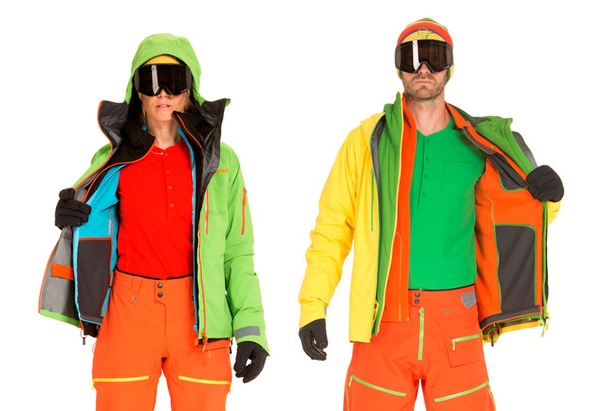One of the major attractions of skiing and snowboarding is that it takes place in some of the most beautiful and stunning landscapes on the planet. However, spending time in mountains exposes you to changeable and possibly dangerous climates. It is therefore vitally crucial that before heading out onto the slopes, you have the ideal clothing and kit to maintain your body temperature. i.e. keeping warm! Being warm and cosy without overheating enables you to keep boarding and skiing for longer. The main purpose of your ski gear is to keep you warm, but at the same time be lightweight and prevent you from getting wet. When we say wet, that’s from both sweat and snow. A wicked system of clothing keeps sweat away from your skin and external wetness from getting back in. The most efficient way of achieving this is be the use of the three layers technique.
It allows you to react to sudden changes in temperature by way of adding layers when it gets colder or by taking a layer off when it gets warmer. The three layers clothing system is applicable to most winter sports and not limited to skiing or snowboarding. If you are doing mountaineering, hiking, climbing, trekking etc – this three layer system has been proven as the de facto and common sense way to dress yourself in the great outdoors. The bottom or base layer, traps in warmth and wicks moisture way from your skin. The mid layer, is normally a fleece top or jacket which give extra insulation. And finally, the outer layer keeps out the wind and rain.

The following guide will tell you to what each layer might comprise of. In turn this will better prepare you with what to wear and why. Note we are not affiliated to any brand or product. The products shown below are only examples.
Base layer
The base layer is the item of clothing that is in contact with your skin. Its purpose is to trap and layer of warm. It should also move moisture away from your skin keeping you warm and dry. The base layer should ideally cover your head, upper body, legs and feet. “Even your head, you may ask? Really?” - Have you ever skied or snowboarded in February? A thin thermal balaclava is very handy. We’re also looking at a long sleeve top, leggings and socks made from a material such as polypropylene which has excellent moisture wicking properties. Cotton is the worst material to act as a base layer because when it gets wet it stays wet, and so do you. It also loses all thermal properties when it gets wet. Also avoid wool blend materials as these can become quite itchy!
Example base layer:
Thermal top
should have long sleeves and made from polypropylene or similar wicking material. This ensures the moisture is transferred away from your skin.

Thermal / sports underwear
Again, go for polypropylene underwear and avoid wearing your best cotton undergarments. If you sweat down there, you’ll stay damp and that’s not fun. Polypropylene underwear is fantastic at keeping you warm and dry.

Thermal leggings / long johns
depending on the outer leg layer (see below) and how cold it is, you may consider some thermal leggings for the ladies and long johns for the men. Make sure they will wick any moisture away from you and are stretchy enough to allow you to move. Given that the core principle of the layer system is to add or remove a layer if it gets too cold or hot, it might be difficult to apply this with leggings. Therefore leggings / long johns are optional.

Skiing socks
Having cold feet and toes is simply the worst feeling. So protecting your digits in freezing conditions is of the highest importance. Invest in some good quality skiing/boarding socks to keep your feet warm, comfortable and dry. They should be thick enough to provide a layer of protection from any knocks Your socks need to come half way up your shin. The also should not be too thick as as they will make your feet sweat.

Lining Socks
Optional, but from personal experience I use them. If you have ever had sweaty feet which often leads to a blister, then these are a never-go-back must have! These are thin non-cotton socks which you put on first, followed by your normal ski socks. Blisters are caused by fabric repeatedly rubbing on your skin. Lining socks not only wick away moisture, any if there is any rubbing, it’s fabric-on-fabric rather than fabric-on-you

Mid or second layer
The purpose of the mid layer is to keep warmth in whilst further wicking any moisture away from your body. Equally on those warmer days, the mid layer can act as an outer layer. Often the mid layer is made from fleece and woollen materials. Again, avoid cotton. The fleece material is ever popular given that it is lightweight with excellent thermal and breathable properties.
Example mid layer
Sweater or Jacket
Preferably a fleece or manufactured from wool. Needs to be lightweight and breathable which will allow any moisture from the base layer evaporate through the fabric. Although it doesn’t necessarily have to act as shield against wind or rain it’s worth considering because it can then double up as an outer layer.

Skiing pants / salopettes
Worn over the top of your base layer, skiing pants or salopettes must not restrict your movement so they need to be roomy. They will offer additional warmth and protection against moisture. Usually they’ll have padded areas in the knees and backside to cushion against a fall. They will also prevent any wetness from melting snow seeping back through to your base layer. Salopettes serve the purpose of giving them up!

Ski / Snowboarding boots
The outer layer for your feet. They come in normal shoe sizes, and keep you attached to your skis or snowboard. Take your time on choosing your boots and make sure they are comfortable. They need to fit round your feet and ankles perfectly. Your boots will be your friend so invest the time in choosing the right pair and they will serve you well for many years.

Outer layer
The outer layer of your three layer wardrobe serves the purpose of shielding you from wind, rain, bumps and stops moisture from getting in. But in turn allows moisture from the inner layers to evaporate and escape. The material for this is often referred to as breathable or Gor-Tex. It is very important! A non-breathable outer layer will trap all the body moisture inside.
Example outer layer:
Beanie, hat or helmet
Ideally your headwear should cover your ears. Your ears are one of your extremities and are susceptible to the cold. It is strongly recommended that you wear a protective helmet. Helmet development have come a long way in recent years and come in numerous styles and include neat features such as built-in pull down visor or camera attachments

Thermal Ski half-mask
Optional and more of an accessory. We're not referring to a balaclava style here. This type of ski mask is a neat little thing you can keep in you pocket and easily put it on should it get a little too cold out there. It is specifically designed for skiing and has a vent enabling to breath normally through your nose and mouth. It keeps your face warm and protected from wind burn without steaming up your goggles. I've been on a chair lift and the person next to me was wearing one. It was so cold I wish I had one. A few hours later I did and haven't looked back since! They are increasing popular and are even comes in cool designs such as skulls, beards, flags, flames, camo patterned and so on.




Skiing goggles
Goggles ought will protect eyes from the outside elements such as wind, snow, rain and UV rays. Goggles come in a variety of different lenses depending on the light conditions. The should prevent you from going snow blind, reduce sun glare and even help you see when the visibility is poor. Make sure the googles have a scratch resistant coating, an anti-fog coating to stop them steaming up and are completely UV safe. The goggles should fit snugly up against your face and the cushioned foam surround is comfortable. A good tip is to check that the googles will fit you regardless of whether you are wearing a helmet or not. Make sure the goggle strap will cater for both situations.

Ski jacket
Your ski jacket is your outer shield layer and will protect you from the unforgiving elements. It must be thermal, water proof wind proof. As with the other garments your jacket must be breathable to allow moisture from your inner layers to evaporate. Ski jackets often have an elasticated nylon inner waist liner. This prevents snow from going up inside your jack should you fall over. When shopping for a ski jacket, look out for a little hidden pocked in the lower sleeve of the left arm. This is to put your ski pass in! You then simply wave your arm up against the ski lift entry gates and you’re in. No more fumbling around trying to find your pass and holding up the queue of people behind you.

Skiing gloves / mitts
Get gloves that are designed for skiing and boarding. They are often insulated with a fleece lining to keep your fingers warm. Make sure they are padded to protect your hands from any knocks. They should also be waterproof as it’s not fun skiing with wet cold hands. Some people prefer mitts as they are much easier to pull on and off that traditional gloves.


When shopping for your skiing and snowboarding gear, ensure that it fits properly to prevent chaffing. Make sure it’s breathable and it will keep you warm, safe and comfortable for the whole day. In return you’ll be rewards with many happy smiles per miles on the slopes whatever the conditions.

